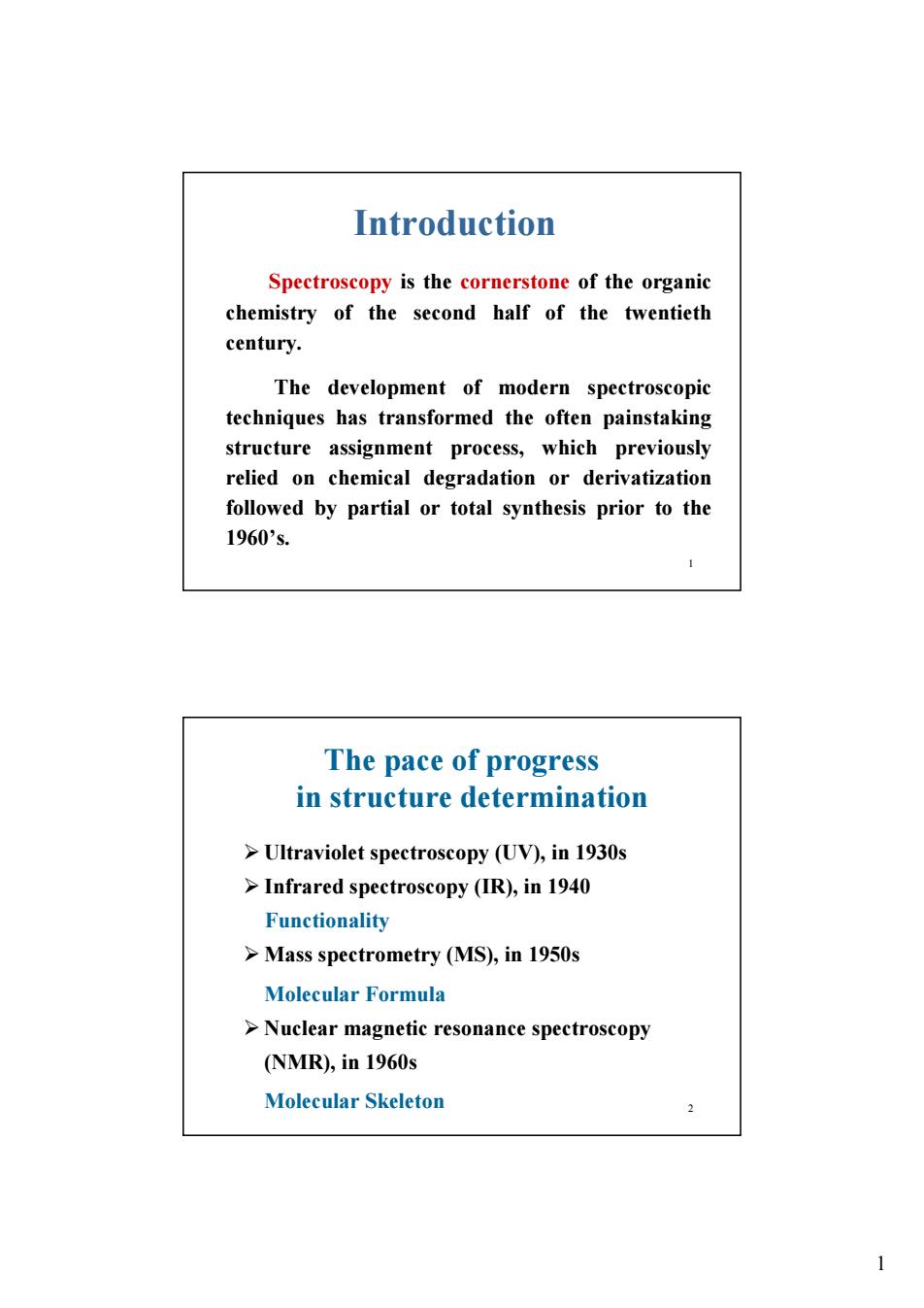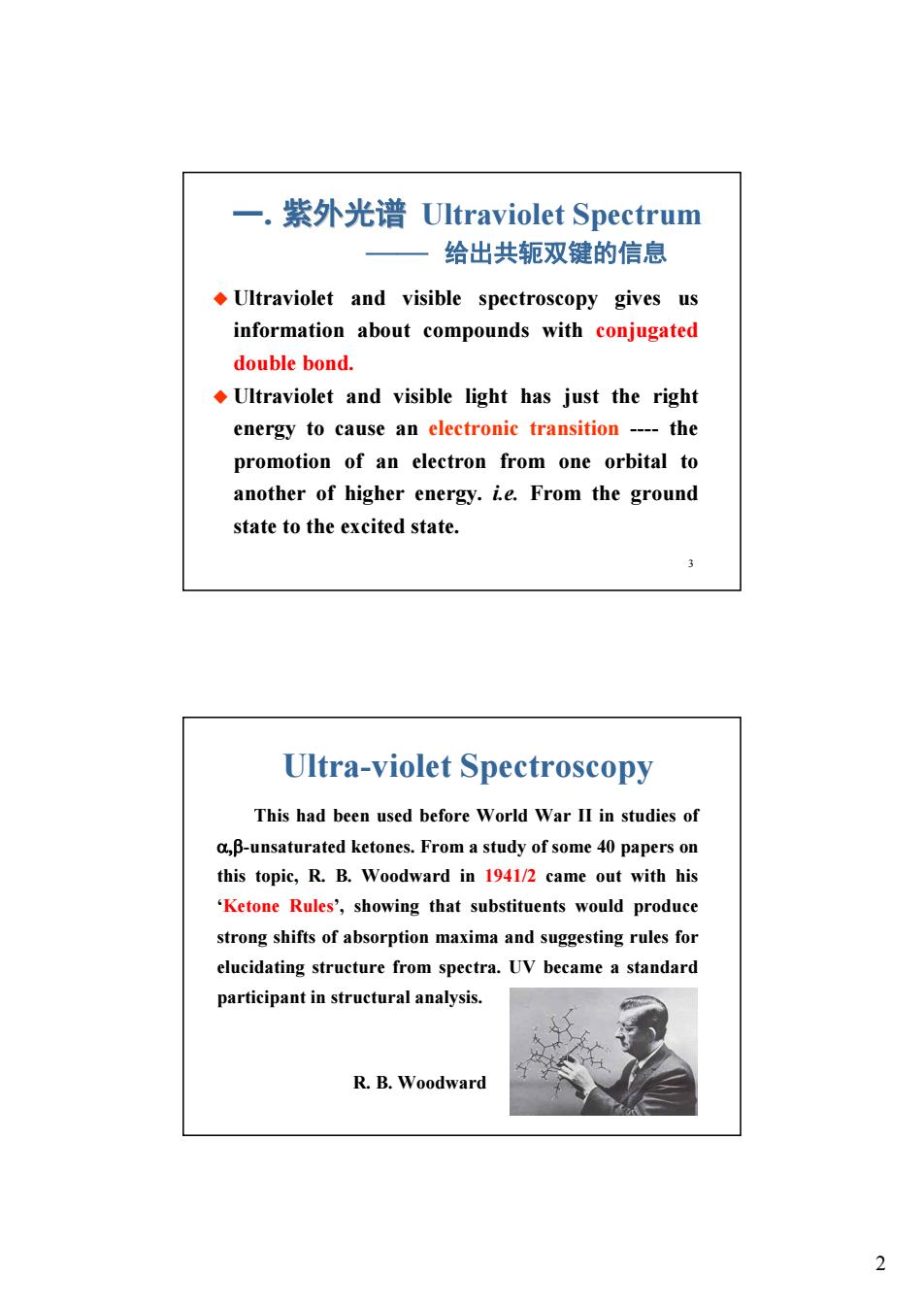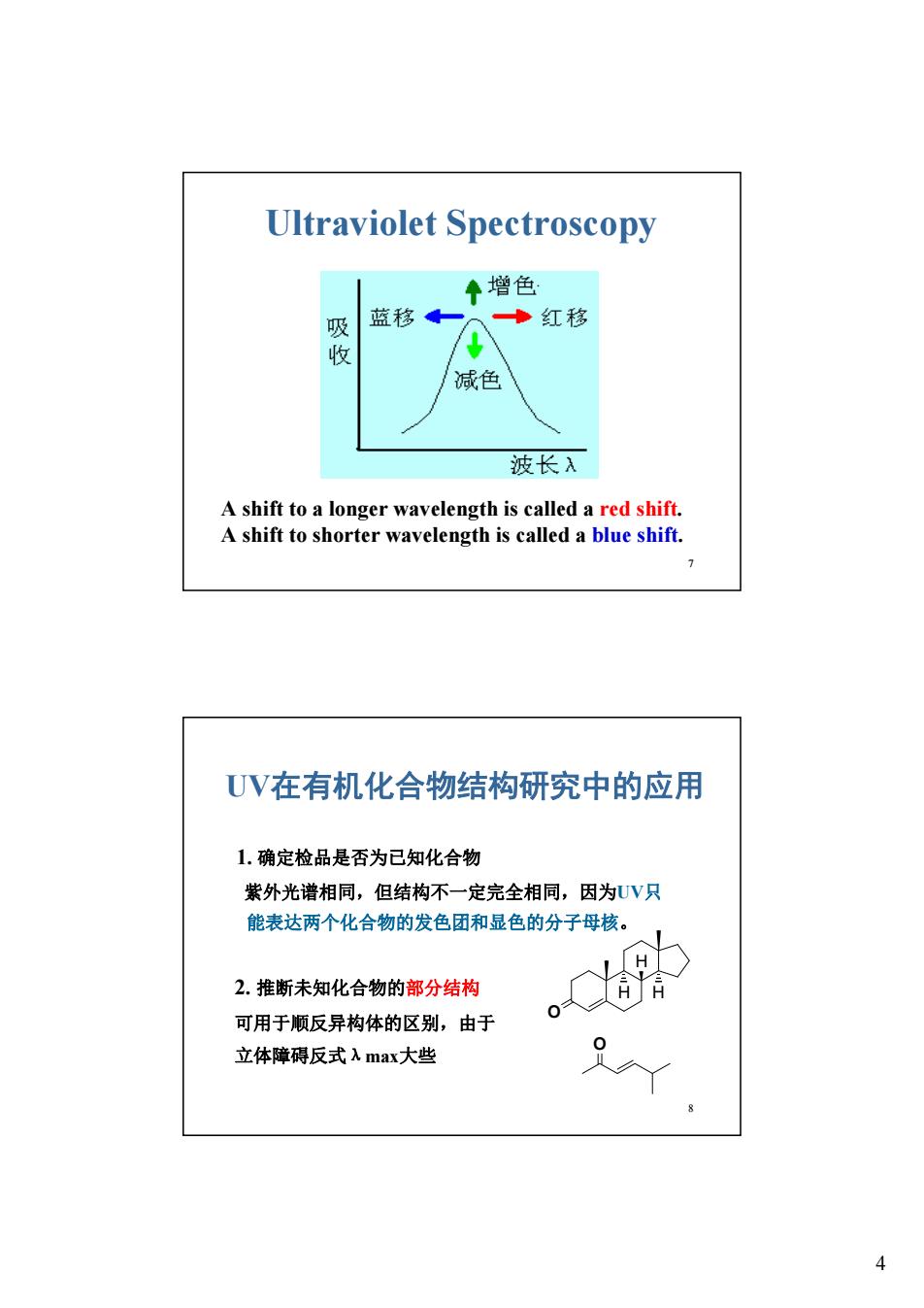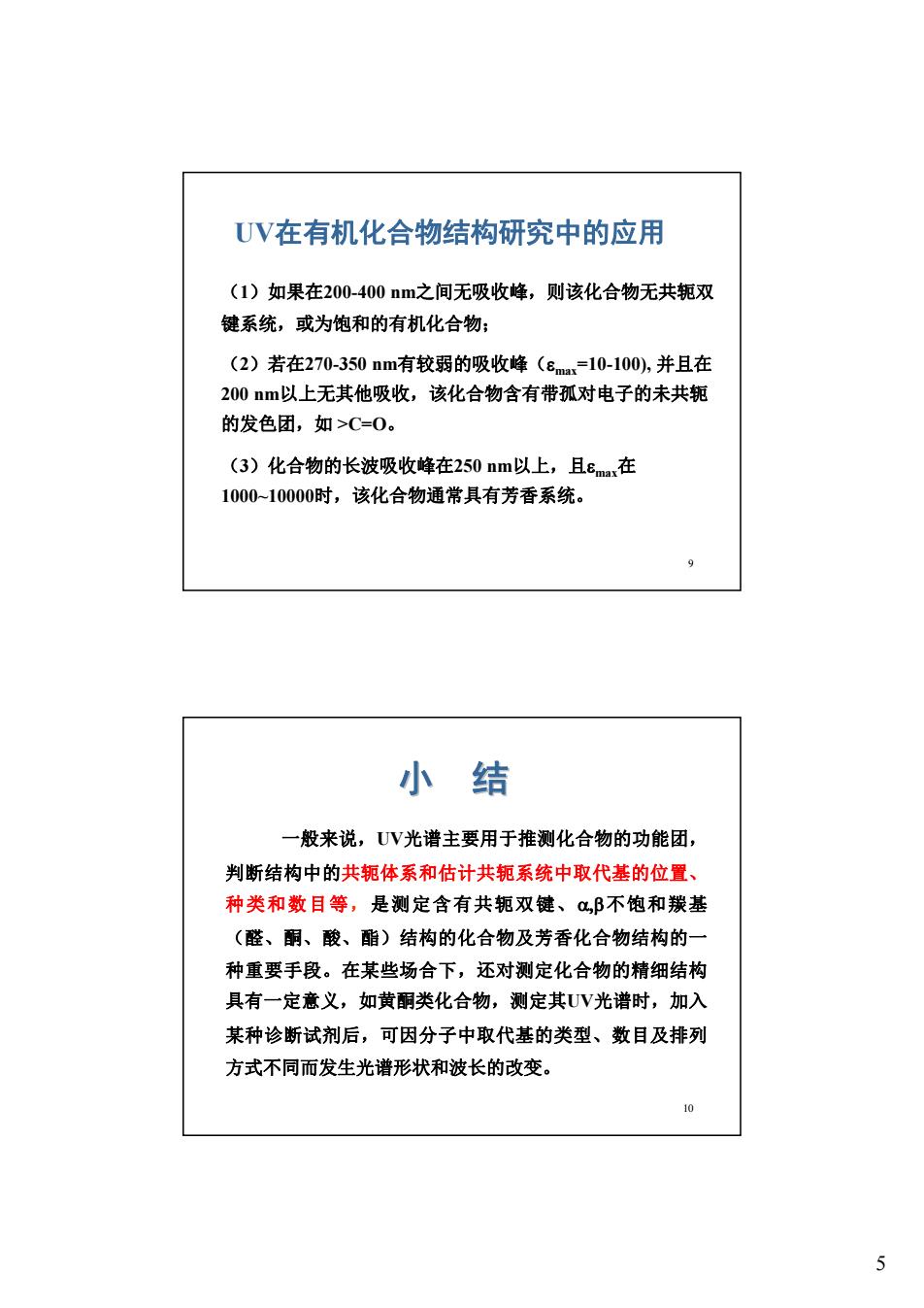
Introduction Spectroscopy is the cornerstone of the organic chemistry of the second half of the twentieth century. The development of modern spectroscopic techniques has transformed the often painstaking structure assignment process,which previously relied on chemical degradation or derivatization followed by partial or total synthesis prior to the 1960's. 1 The pace of progress in structure determination >Ultraviolet spectroscopy (UV),in 1930s >Infrared spectroscopy (IR),in 1940 Functionality >Mass spectrometry (MS),in 1950s Molecular Formula >Nuclear magnetic resonance spectroscopy (NMR),in 1960s Molecular Skeleton
1 1 Introduction Spectroscopy is the cornerstone of the organic chemistry of the second half of the twentieth century. The development of modern spectroscopic techniques has transformed the often painstaking structure assignment process, which previously relied on chemical degradation or derivatization followed by partial or total synthesis prior to the 1960’s. 2 The pace of progress in structure determination Ø Ultraviolet spectroscopy (UV), in 1930s Ø Infrared spectroscopy (IR), in 1940 Functionality Ø Mass spectrometry (MS), in 1950s Molecular Formula Ø Nuclear magnetic resonance spectroscopy (NMR), in 1960s Molecular Skeleton

一.紫外光谱Ultraviolet Spectrum 一给出共轭双键的信息 Ultraviolet and visible spectroscopy gives us information about compounds with conjugated double bond. Ultraviolet and visible light has just the right energy to cause an electronic transition---the promotion of an electron from one orbital to another of higher energy.ie.From the ground state to the excited state. Ultra-violet Spectroscopy This had been used before World War II in studies of B-unsaturated ketones.From a study of some 40 papers on this topic,R.B.Woodward in 1941/2 came out with his 'Ketone Rules',showing that substituents would produce strong shifts of absorption maxima and suggesting rules for elucidating structure from spectra.UV became a standard participant in structural analysis. R.B.Woodward
2 3 一. 紫外光谱 Ultraviolet Spectrum —— 给出共轭双键的信息 u Ultraviolet and visible spectroscopy gives us information about compounds with conjugated double bond. u Ultraviolet and visible light has just the right energy to cause an electronic transition ---- the promotion of an electron from one orbital to another of higher energy. i.e. From the ground state to the excited state. 4 This had been used before World War II in studies of a,b-unsaturated ketones. From a study of some 40 papers on this topic, R. B. Woodward in 1941/2 came out with his ‘Ketone Rules’, showing that substituents would produce strong shifts of absorption maxima and suggesting rules for elucidating structure from spectra. UV became a standard participant in structural analysis. Ultra-violet Spectroscopy R. B. Woodward

Ultraviolet Spectrometer Ultraviolet Spectroscopy A chromophore is that part of a molecule that is responsible for a UV or visible absorption spectrum. An auxochrome (auxochromic group)is a substituent that,when attached to a chromophore, alters the Amax and/or the intensity of the absorption,usually increasing both of them. (OH and NH,are auxochromes) 6
3 5 Ultraviolet Spectrometer 6 A chromophore is that part of a molecule that is responsible for a UV or visible absorption spectrum. An auxochrome (auxochromic group) is a substituent that, when attached to a chromophore, alters the λmax and/or the intensity of the absorption, usually increasing both of them. (OH and NH2 are auxochromes) Ultraviolet Spectroscopy

Ultraviolet Spectroscopy 个增色 吸 蓝移← ·红移 减色 波长入 A shift to a longer wavelength is called a red shift. A shift to shorter wavelength is called a blue shift. UV在有机化合物结构研究中的应用 1.确定检品是否为已知化合物 紫外光谱相同,但结构不一定完全相同,因为V只 能表达两个化合物的发色团和显色的分子母核。 H 2.推断未知化合物的部分结构 0 可用于顺反异构体的区别,由于 立体障碍反式λmax大些 0 4
4 7 A shift to a longer wavelength is called a red shift. A shift to shorter wavelength is called a blue shift. Ultraviolet Spectroscopy 8 UV在有机化合物结构研究中的应用 1. 确定检品是否为已知化合物 紫外光谱相同,但结构不一定完全相同,因为UV只 能表达两个化合物的发色团和显色的分子母核。 2. 推断未知化合物的部分结构 可用于顺反异构体的区别,由于 立体障碍反式λmax大些 O O H H H

UV在有机化合物结构研究中的应用 (1)如果在200-400nm之间无吸收峰,则该化合物无共轭双 键系统,或为饱和的有机化合物: (2)若在270-350nm有较弱的吸收峰(ε=10-100,并且在 200nm以上无其他吸收,该化合物含有带孤对电子的未共轭 的发色团,如>C=0。 (3)化合物的长波吸收峰在250nm以上,且8在 1000-10000时,该化合物通常具有芳香系统。 小结 一般来说,UV光谱主要用于推测化合物的功能团 判断结构中的共轭体系和估计共轭系统中取代基的位置、 种类和数目等,是测定含有共轭双键、aB不饱和羰基 (醛、酮、酸、酯)结构的化合物及芳香化合物结构的 种重要手段。在某些场合下,还对测定化合物的精细结构 具有一定意义,如黄酮类化合物,测定其V光谱时,加入 某种诊断试剂后,可因分子中取代基的类型、数目及排列 方式不同而发生光谱形状和波长的改变。 10
5 9 (1)如果在200-400 nm之间无吸收峰,则该化合物无共轭双 键系统,或为饱和的有机化合物; (2)若在270-350 nm有较弱的吸收峰(emax=10-100), 并且在 200 nm以上无其他吸收,该化合物含有带孤对电子的未共轭 的发色团,如 >C=O。 (3)化合物的长波吸收峰在250 nm以上,且emax在 1000~10000时,该化合物通常具有芳香系统。 UV在有机化合物结构研究中的应用 10 一般来说,UV光谱主要用于推测化合物的功能团, 判断结构中的共轭体系和估计共轭系统中取代基的位置、 种类和数目等,是测定含有共轭双键、a,b不饱和羰基 (醛、酮、酸、酯)结构的化合物及芳香化合物结构的一 种重要手段。在某些场合下,还对测定化合物的精细结构 具有一定意义,如黄酮类化合物,测定其UV光谱时,加入 某种诊断试剂后,可因分子中取代基的类型、数目及排列 方式不同而发生光谱形状和波长的改变。 小 结